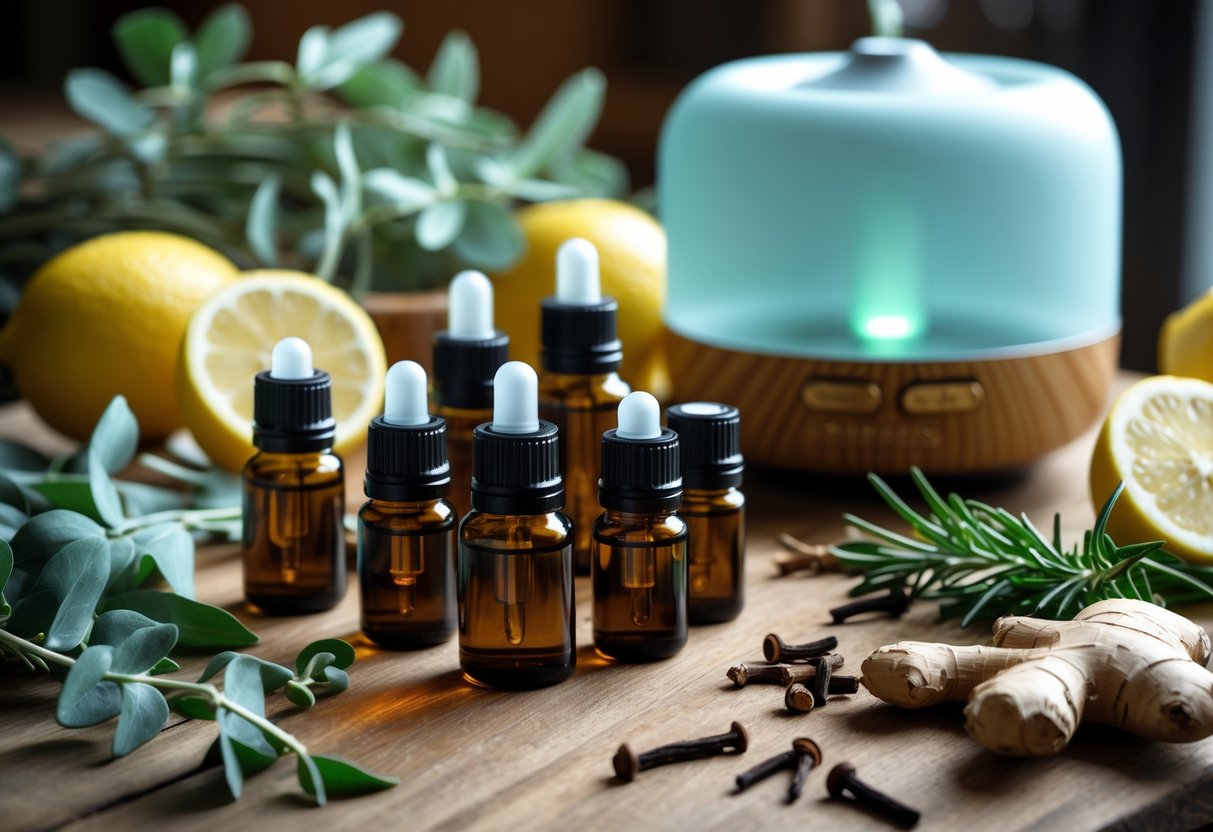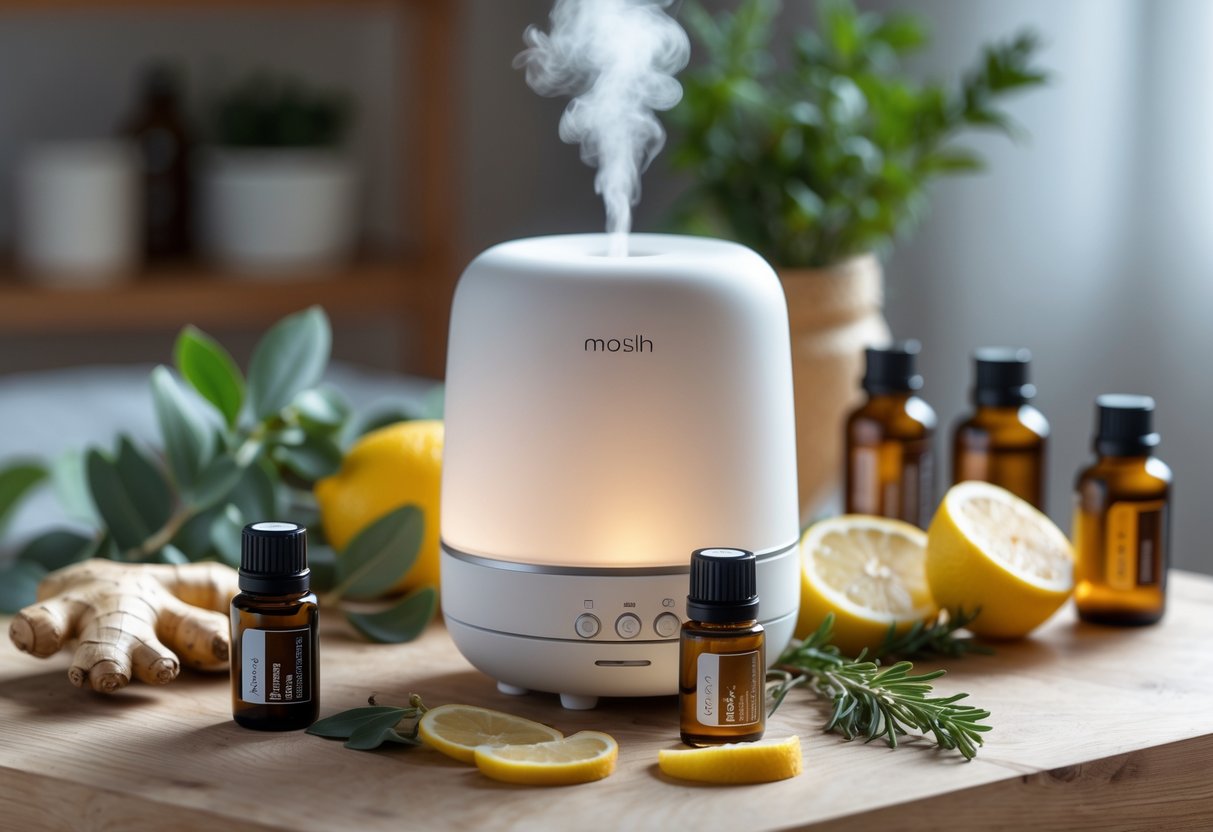Essential Oils To Diffuse During Cold And Flu Season For A Healthier Home

When you buy through links on our site, we may earn an affiliate commission at no additional cost to you (learn more)
When cold and flu season hits, the air can start to feel heavy and stale. Diffusing essential oils can help freshen the space and support a calm atmosphere. The best essential oils to diffuse during cold and flu season are those that can ease congestion, promote comfort, and create a soothing environment.
Simple options like eucalyptus, peppermint, and tea tree oil can help the air feel cleaner and easier to breathe. Families often turn to lavender or lemon for a gentle scent that still feels refreshing. The right blend can make a home feel more comfortable when everyone needs extra care.
Top Essential Oils to Diffuse for Cold and Flu Season

Diffusing essential oils can support clearer breathing, help reduce airborne microbes, and create a cleaner-smelling home environment. Each oil offers unique properties that may ease cold and flu symptoms and support comfort during recovery.
Eucalyptus Oil Benefits
Eucalyptus oil contains a compound called cineole, known for its ability to help clear nasal passages and ease chest congestion. When diffused, it can create a cooling, refreshing scent that promotes easier breathing. Many people find it helpful when dealing with sinus pressure or a stubborn cough.
It is often used to support respiratory health because it helps loosen mucus and improve airflow. Inhalation of eucalyptus vapor can make breathing more comfortable, especially during cold weather.
Some prefer blending it with other oils like lemon or rosemary for a cleaner aroma and added antiseptic effect. A few drops in a diffuser can freshen indoor air and create a more breathable space without feeling harsh or overwhelming.
Peppermint Oil for Respiratory Relief
Peppermint oil’s menthol content provides a cooling effect that can soothe irritated airways. When inhaled through diffusion, it helps open nasal passages and support normal airflow. This can reduce the feeling of a stuffy nose while producing a crisp and energizing scent.
It may also ease minor headaches or fatigue that often come with colds. Some find that pairing peppermint with eucalyptus or lavender adds both comfort and freshness to the air.
Usage tips:
- Add 3–5 drops to a diffuser with water.
- Limit strong concentrations to avoid eye or throat irritation.
- Avoid using by young children or near pets unless properly diluted.
Tea Tree Oil for Purifying Air
Tea tree oil contains compounds with cleansing and purifying properties. When diffused, it helps reduce stale or musty smells and can decrease airborne bacteria levels in closed spaces. Its sharp, medicinal aroma indicates its strong nature.
Diffusing tea tree oil may also help limit the spread of common microbes during cold and flu season. Some people combine it with citrus oils like lemon to soften its scent while enhancing deodorizing effects.
It works best in small amounts because of its potency. A mild concentration can make indoor air feel cleaner and more balanced without being overpowering.
How to Safely Diffuse Essential Oils During Illness
Using essential oils during illness can support comfort, reduce unpleasant odors, and create a calming environment. Choosing the proper tools, suitable oil amounts, and following clear safety steps helps reduce risks and keeps the air healthy for everyone in the room.
Choosing the Right Diffuser
A cool mist ultrasonic diffuser works well because it uses water and vibration instead of heat. This keeps the oils’ properties stable while adding gentle moisture to dry indoor air. People should select a diffuser with an auto-shutoff feature and easy-to-clean parts to prevent bacteria buildup.
Diffusers come in several types:
| Type | Key Features | Best Use |
|---|---|---|
| Ultrasonic | Water-based, quiet, safe | Everyday home use |
| Nebulizing | Pure oil, strong scent | Short sessions |
| Evaporative | Uses airflow, simple setup | Quick diffusion |
Cleaning the diffuser every few days with mild soap and warm water helps keep it safe. They should avoid placing it near the bed or directly toward someone’s face to prevent irritation.
Recommended Blends and Dosages
A balanced blend makes a noticeable difference in comfort. Eucalyptus, peppermint, and tea tree oils are popular choices known for their refreshing scent. When blended in small amounts, these oils can open the airways without becoming overpowering.
Recommended blend ideas:
- Refreshing mix: 2 drops eucalyptus, 1 drop lemon, 1 drop peppermint
- Calming mix: 2 drops lavender, 1 drop tea tree, 1 drop rosemary
Diffusers should run 20–30 minutes at a time, then rest for at least an hour. Overuse can make the scent too strong or cause dryness. For smaller rooms, a total of 3–5 drops is usually enough.
Precautions and Safety Tips
Even natural oils can irritate when used incorrectly. Always dilute properly and check sensitivity before diffusing around children, pets, or people with asthma. Avoid peppermint and strong menthol oils for infants and toddlers.
Ensure fresh air circulation by opening a window slightly. If anyone experiences coughing or headaches, stop diffusing and air out the room.
Store all oils in dark glass bottles away from heat and light. Label blends clearly and keep them out of reach of children. Responsible use keeps essential oils comfortable and safe during illness.



